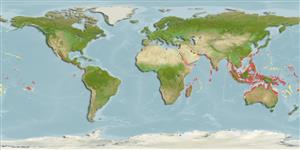Common names from other countries
Environment: milieu / climate zone / depth range / distribution range
Ecologie
marien; zoet water; brak water demersaal; katadroom (Ref. 46888); diepte 0 - 5 m (Ref. 86942). Tropical; 30°N - 35°S, 24°E - 138°W
Indo-Pacific: Persian Gulf (Ref.80050) and Red Sea to Samoa, north to Japan. Collected at Natal, South Africa (Ref. 11228).
Grootte / Gewicht / Leeftijd
Maturity: Lm ? range ? - ? cm
Max length : 40.0 cm SL mannelijk / geslacht onbekend; (Ref. 9812); common length : 25.0 cm TL mannelijk / geslacht onbekend; (Ref. 9812)
Dorsale stekels (totaal) : 4 - 5; Dorsale zachte stralen (totaal) : 8 - 9; Anale stekels: 3; Anale zachte stralen: 9. Dark greenish dorsally, brownish over head, white ventrally; 3-6 indistinct, dark stripes along upper rows of scales; greyish dorsal fins; caudal fin bluish with black margin (Ref. 9812). Yellowish pectoral fin and may have a blue spot at fin origin (Ref. 9812).
Form schools in shallow coastal waters and enters lagoons, estuaries, and fresh water to feed (Ref. 9812). Juveniles may enter rice fields and mangroves (Ref. 9812). Feed on small algae, diatoms and benthic detrital material taken in with sand and mud; fry take zooplankton, diatoms, detrital material and inorganic sediment (Ref. 9812). Oviparous, eggs are pelagic and non-adhesive (Ref. 205). Spawning occurs at sea. Also caught with stakenets (Ref. 9812). Marketed fresh and salted.
Levenscyclus en paargedrag
Maturities | Voortplanting | Spawnings | Egg(s) | Fecundities | Larven
Thomson, J.M., 1984. Mugilidae. In W. Fischer and G. Bianchi (eds.) FAO species identification sheets for fishery purposes. Western Indian Ocean (Fishing Area 51). volume 3. [pag. var.]. FAO, Rome. (Ref. 2830)
Status op de Rode Lijst van het IUCN (Ref. 130435)
CITES (Ref. 128078)
Not Evaluated
Gevaar voor de mens
Harmless
Gebruik door de mens
Visserij: commercieel; Aquacultuur: commercieel; aas: usually
Tools
Speciale rapporten
Download XML
Internetbronnen
Estimates based on models
Preferred temperature (Ref.
115969): 25.2 - 29.3, mean 28.4 (based on 3436 cells).
Fylogenetische diversiteitsindex (Ref.
82804): PD
50 = 0.5078 [Uniqueness, from 0.5 = low to 2.0 = high].
Bayesian length-weight: a=0.01259 (0.01053 - 0.01505), b=2.93 (2.90 - 2.96), in cm Total Length, based on LWR estimates for this species (Ref.
93245).
Trofisch niveau (Ref.
69278): 2.7 ±0.30 se; based on food items.
Weerstandsvermogen (Ref.
120179): Gemiddeld, minimale populatieverdubbelingstijd 1,4-4,4 jaar (K=0.15-0.63).
Fishing Vulnerability (Ref.
59153): Low to moderate vulnerability (32 of 100).
